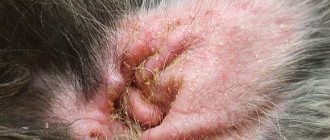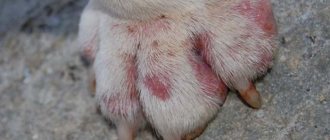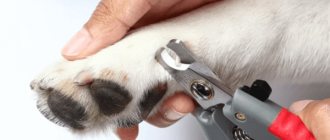What is fever in dogs? Pet is hot to the touch
The normal body temperature for dogs is between 38 and 39.0 degrees Celsius, which is higher than that of humans. This means that your dog may be hot to the touch, even if his temperature is completely normal. There is also a temperature limit from 39 to 39.5 degrees, when it is impossible to reliably estimate the temperature. Within this limit, it can be normal or increased. Therefore, you need to pay attention to additional symptoms - activity and appetite. In rare cases, temperatures of 40 and above occur in healthy dogs after intense exercise or stress. After resting and calming down, you need to measure your temperature (after 30 minutes).
The word fever is commonly used to describe increased body temperature caused by infection or inflammation. A temperature exceeding 39.5 degrees is considered elevated, although it can also be 40 if the dog is very excited or under stress. You need to let it breathe and re-measure after 30 minutes. If the temperature drops, everything is fine; if not, you need to show your pet to the veterinarian.
When dogs have a high fever, which is the result of heat or excessive exercise in humid conditions, the condition is called hyperthermia or heatstroke. When the temperature reaches 40.5 degrees, serious and fatal complications can occur.
Causes of hot ears in dogs
In fact, this symptom is not alarming unless there are any additional complaints about the dog’s well-being, for example:
- lethargy,
- poor appetite
- vomiting, diarrhea,
- itching, scratching on the ear,
- temperature,
- swelling of the muzzle.
The main reasons for this symptom may be:
- Stress, overexcitement, fear.
With strong emotional arousal, the dog’s pulse quickens, blood pressure and blood supply to organs, including the ears, increase. Which can lead to an increase in the temperature of the external auditory canal. This does not affect the overall health of the dog in any way. - Temperature.
Only by measuring your dog's temperature can you tell for sure whether it is there or not. The surface of the ears, nose, and abdomen are not a reliable indicator of hyperthermia in animals. The temperature is measured rectally using a conventional electronic thermometer and is within normal limits from 37.5 to 39 degrees. An increase in temperature is a symptom that should be addressed by a veterinarian. And an increase in ear temperature without measuring the dog's rectal temperature does not mean anything. - Otodectosis, otitis.
The presence of ear mites (otodectosis) or ear inflammation (otitis) in a dog is usually accompanied by itching and constant scratching of the ears. The dog shakes its head, the ears may become red and hot, and there is often discharge from the ears or a specific unpleasant odor. Just a hot ear without these additional symptoms and the dog is in good health should not embarrass the owner. - Allergic reaction.
An allergic reaction is accompanied not only by hyperthermia of the ears. There must be accompanying symptoms - itching, swelling of the muzzle, feeling unwell. - Heatstroke.
When exposed to the sun for a long time or in a stuffy, warm room (for example, in a closed car), the dog's overall body temperature and external auditory canal may increase. Be sure to show your dog to a veterinarian if she also develops lethargy, vomiting, or fever. Heatstroke is life-threatening and requires immediate action. If the dog feels well, but you suspect that it may overheat, give it a lot of cool drinks, take it to the shade, or bathe it in a pond in hot weather.
Symptoms of Dog Fever
Although there are no definite signs, some symptoms that may indicate illness and fever in dogs include:
- Lethargy
- Depression
- Shiver
- Loss of appetite
- Vomit
- Cough
- Nasal discharge
- A hot head in a pet is a sign of an increase in general or local temperature (inflammatory processes in the head area)
- Hot ears (inflammation of the ears or general fever)
- Hot and dry nose (signs of general malaise)
- Hot paws (fever or local inflammation, compare the temperature on all four limbs and on the tail)
- How to care for a dog with a fever or fever at home when you need to call the vet?
Why does a dog have a red ear inside?
Dachshund owners should be especially vigilant if the dog’s ears are red inside and itchy. The structural features of this unique breed give it a number of advantages over others when hunting foxes and other animals living in burrows. To enhance their sense of smell, they completely cover their hearing organs with their long ears and nothing, no one in this position will distract the dachshund from the scent. So our pets pay for their uniqueness with their ears. They are located almost near the ground, so dirt, dust, plants, and insects actively attack the dachshund’s hearing organs. The owner should be vigilant when cleaning his pet's ears regularly; the skin on the inner surface of the shell should be pale pink.
The skin of a dog's ears may turn red due to the following irritating factors:
- Insects. Bites and penetration of parasites can cause illness in your pet. Ear mites are especially dangerous in summer. They become the reason why the dog's ears are red inside. Their prolonged presence is fraught with complete deafness for the dog. It is very problematic for any creature to survive the loss of one of the basic senses for life. The animal will have to adapt to new living conditions. Not every dog is able to cope with such a loss. A lot in this case will depend on the owner;
- Plants. The fauna is full of dangerous irritants, the contact of which with delicate skin can cause inflammation or an allergic reaction. As a result, the dog has redness in the ear. It is possible for grass to get inside the ear opening; its accumulation also leads to inflammatory processes. Well, plants with sharp and prickly fruits can injure the auricle, which ultimately results in a terrible blood poisoning when dirt and dust get into the wounds. Its consequences for animals are no less sad than for humans. Unfortunately, in a situation where a dog has a red ear and itches, our pets are not able to provide first aid and lick their wounds. Here all hope lies in a responsible owner;
- Inflammatory processes in the dog's body. Many factors contribute to the development of otitis media. Infection can occur in a variety of ways. As a result, the dog gets a red ear and it smells. This unpleasant disease can be provoked by the insects and plants listed above, as well as hypothermia. It is advisable to recognize this disease at an early stage so that it does not become chronic and thereby develop into systematic worries for your four-legged friend. In addition to the fact that the dog’s ears are red inside, otitis media makes itself felt by an unpleasant odor and narrowing of the ear opening due to inflammation of the external tissues. As a result, the dog’s ears are red inside; when palpating the parotid surface, swelling and squelching inside the ear are observed.
When you need to urgently take a patient to a veterinary clinic
The only accurate way to determine if your dog has a fever is to take his rectal temperature.
Experts recommend using a digital thermometer specifically designed for rectal use in dogs. Most thermometers designed for use in the human ear are not suitable for this purpose.
To take your dog's temperature, first coat the thermometer with a lubricant such as petroleum gel or baby oil. Then carefully insert the thermometer one to two centimeters into your dog's anus and wait for the results. Most thermometers will take less than 60 seconds to register for this purpose. You can also use a mercury thermometer, but you need to measure for at least 5 minutes.
Make sure your dog's ear doesn't turn red
The most effective countermeasure when the question arises - a dog has a red ear inside and how to treat it is prevention. The owner is required to provide a systematic examination and, if necessary, clean the pet’s ears with cotton swabs or special drops when black fungal deposits appear. Do not be overzealous when cleaning the ear opening from wax. This way you will prevent the natural removal of dirt accumulated inside. Earwax acts like mucous in the eyes. Active production of sulfur deposits indicates the need for a visit to the veterinarian. A specialist will determine why your dog’s ear is red and smells. Depending on the criticality of the situation, he will rinse the ear on the spot or prescribe medications to help remove dirt from the ears.
Causes of Dog Fever
A variety of diseases and conditions can cause your dog to develop a fever. These include:
- Infection. Can have any number of causes of infectious disease in dogs, including bacterial, fungal and viral diseases. The infection can be anywhere in the body, such as the lungs (pneumonia), kidneys (pyelonephritis), brain (encephalitis), or even the skin. The symptoms you see will depend on where the infection is and the cause. Some infections, such as fungal infections, can cause inflammation in multiple areas of the body at the same time.
- Vaccination. An increase in general and local temperature after vaccination within 24-48 hours after vaccination is not uncommon and is the result of interaction between the injection and the dog's immune system.
- Toxins. Consumption of substances that are toxic to dogs, including macadamia nuts and some antidepressants, can cause an increase in body temperature.
- There are times when the cause of a dog's fever cannot be easily determined; this is called "fever of unknown origin." The most likely causes of canine fever of unknown origin are immune system disorders, bone marrow problems, undiagnosed infections and cancer.
What to do if your dog has hot ears
Touch your pet's fluffy velvet ear. If it is hot, but the dog behaves as usual, is cheerful, cheerful, plays with pleasure and absorbs food, then most likely the reason for the increase in ear temperature is due to overexcitation or the fact that it is simply hot in the house (outside). Provide your dog with drinking water and a cool place to rest in the shade, and monitor his condition. If no negative symptoms appear, there is nothing to worry about - the dog is healthy and no treatment is required.
Home care and when to call the vet
If your dog has a temperature above 39, you should call your veterinarian. Fever above 40 is an emergency that must be addressed promptly.
If your dog has a temperature above 100 degrees Fahrenheit, you can lower his body temperature by running cool water on his fur, especially around the ears and paws.
Using a fan on damp wool will help reduce the temperature. When doing this, be sure to monitor your dog's rectal temperature and stop the cooling procedure when it reaches 39.5. You should not lower the temperature too quickly.
If your dog has a fever, try to make sure he drinks enough water regularly to stay hydrated, but don't force it. And never give your dog medications meant to reduce fever, such as acetaminophen or ibuprofen, as these can be poisonous to dogs and cause serious stomach, liver and kidney damage or death.
^Top
Good to know
- Rapid breathing in dogs. What to do if you have increased breathing? What types of breathing problems do dogs have?
- Why does my dog often vomit yellow or white foam? Treatment for vomiting in dogs
- Why doesn't the dog eat anything? Causes, aspects of diagnosis, treatment and prevention. What to do if your dog won't eat food or food?
- Why does a dog scratch its ears and shake its head (reasons, range of diseases, diagnosis, treatment and prevention). Why does my dog constantly shake his ears?
- What is the reason why a dog constantly whines? How to solve this problem? When should you contact a veterinarian?
- Why is my dog breathing heavily and frequently? First aid for a dog with difficulty breathing
- Why does a dog eat cat feces? The problem is serious and urgent. Find out how to correct this bad habit
- Why does a dog drink a lot of water? The main causes of thirst in dogs and tactics for animal owners. What should you do if your older dog starts drinking a lot of water?
- Eye Discharge in Dogs - Why do my dog's eyes water or have discharge?
- Why does a young dog have bad breath? Have you considered the main causes of unpleasant mouth odor in dogs? An elderly dog has bad breath, what should I do?
- Why can a dog lose hair in patches or all over its body? What is the reason? What to do? How to treat hair problems in dogs?
- Why does my dog have diarrhea? Dog diarrhea (causes, pathogenesis, diagnosis, signs and symptoms, first aid, treatment and prevention)
- How to treat bartonellosis in dogs? Bartonella is a causative agent of septic processes in animals and humans. How to make a correct diagnosis?
- Canine bordetelosis (epizootology, distribution, pathogenesis, symptoms and signs, treatment and prevention). Bordetella in dogs (Bordetella bronchiseptica)
- How to treat adenovirus in dogs? How to make a correct diagnosis? Symptoms, treatment, prevention and vaccination for adenovirus infection in dogs
- Why is the dog lethargic and constantly lying down? Oppression of dogs. When should you seek veterinary help?
Main reasons
The causes of a hot nose in a dog can be very different, and this does not always indicate the presence of a dangerous disease. However, there may also be serious violations, in particular such as:
- allergy;
- colds;
- mechanical damage;
- pemphigus.
Pemphigus is a disease of the autoimmune system, accompanied by the appearance of blisters in the nose area. Gradually, the new growths burst, dry out, and a crust forms. After some time, the blisters spread to the entire surface of the body.
To determine why your dog has a hot nose, you need to consult a veterinarian, as this may be the cause of a dangerous disease. Stressful situations, as well as environmental changes, can provoke changes in the animal’s body. All the emotions experienced can also cause dryness.











